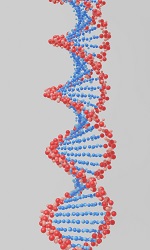
A newspaper headline in 1939 declared "Woman Scientist Explains" when talking about Florence Bell because there were so few of them. The thing is Bell deserved the accolade, regardless of whether she was a man or woman. She was the first to take an image of our DNA using a technology called x-ray crystallography.
Shortly after graduating from Girton College in 1935, she began working with Lawrence Bragg and his father. The pair had won a Nobel Prize for the discovery of X-Ray crystallography.
The Braggs had shown how X-rays could be used to reveal the arrangement of atoms and molecules in simple crystals such as salt. Other scientists applied the technique to biological molecules and Bell left to join that work. Soon she began describing the structure of protein fibers in jellyfish, shark fins, and hair. Then she published images of the thymonucleic acid, what we now call DNA.
Descriptions using the images were helpful to the scientists Watson and Crick who eventually proposed the double helix model of the DNA we know today. That opened the door for molecular biology.
Bell's work halted when she was required to serve in World War two developing air radar systems. She then left for the US to marry and work for a petroleum company before quitting altogether to raise her children. She died in the year 2000 and makes us wonder what amazing work was left undone when Florence Bell left science.
More Information
Florence Bell: the 'housewife' who played a key part in our understanding of DNA
When the Yorkshire Evening News reported on an address delivered by 25-year-old physicist Florence Bell at a scientific conference held in Leeds in 1939, it wasn't her science that made the headlines, but simply the fact that she was a woman doing science...
Watson and Crick took all the glory, but there's a forgotten hero of the double helix
In the world of sport, we remember a winner. Not many people have heard of Pierre Rolland, who finished eighth in the 2012 Tour de France. But everyone knows Bradley Wiggins, who won it. The history of science is often also described in similar terms - as a tale of winners and losers racing to the finish line. Nowhere is this truer than in the story of the discovery of the structure of DNA...
Florence Bell, an unsung physics and DNA pioneer
IValerie Jamieson reports real-life experiences of women in physics in her article on why there are so few women in that field (10 November, p 32). The physicist Florence Bell would have agreed. Her PhD supervisor, William Astbury, declared that "there is a creative spark in the male that is absent from women, even though the latter do such marvellously conscientious and thorough work after the spark has been struck"...